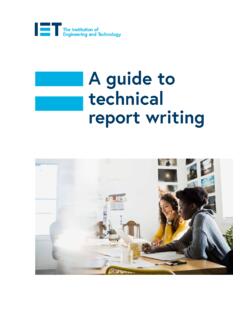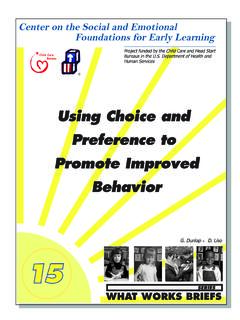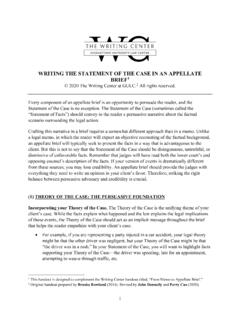Transcription of A Brief Introduction to Social Media
1 The Institution of Engineering and Technology 2015 Page 1 A Brief Introduction to Social Media Contents 1. What is Social Media ? .. 1 2. Facebook, LinkedIn and Twitter .. 2 3. Academic and specialist networks and resources .. 3 4. Things to do and things to avoid .. 4 About the IET .. 4 Charity Statement .. 4 1. What is Social Media ? Social Media is as a set of software and web tools that help users interact online, share content and develop a personalised network of friends, colleagues or organisations. Every individual uses their network differently, and there are no set rules about what is right for each site. However, the key word here is Social . Users come to Social Media sites to talk to friends, share ideas and hear the latest news. They do not, in general, log in to their accounts intending to buy something. Even on the more career-focused sites like LinkedIn, direct sales messages have to be done only rarely and with care.
2 Instead of posting simply buy me messages for your book, there are plenty of other approaches. You could consider the following: Write an article about your work and post a link to it in relevant groups and forums; remember to add a note about your book. Join groups relevant to your work and keep an eye on other users comments. Is someone asking a question you can answer? Then answer it and put in a link to your home page or blog or anywhere that your book can be found. Something in the news relevant to your work? Make sure your friends and colleagues know it! In short, Social Media works best if you participate and support the communities you join. If you share a link to your book before anyone knows who you are, it won t generate much interest. However, if you have earned a reputation as an active and constructive participant, an announcement about your book will be warmly received.
3 If you are interested in learning more about Social Media , there are many books, blogs and websites which are easy to find with a quick search on Google or your preferred search engine. Once you begin, you will find that it is not difficult, although it does require a little dedication and patience. The Institution of Engineering and Technology 2015 Page 2 2. Facebook, LinkedIn and Twitter The sites described here are among the best known and most popular. In every case, connecting with someone on Social Media requires mutual consent, and either side can choose to break the connection. Important note: if you are concerned about privacy, be sure to check out the privacy settings on all the Social Media sites you use, since the default settings are not to everyone s taste. Facebook Facebook has 800 million users, making it a good place to promote your book to a potentially huge audience.
4 You can sign up for an account at Allows you to find friends and colleagues and join their networks. Lets you share text, links, images and video to all your friends. Encourages sharing of posts, so that friends of friends can see what you have posted. If they like, they also share it further on their own networks. This multi-stage sharing across different Social groups is one of the things that make Facebook so appealing as a place to mention your book. There are a range of functions which you can explore, including o set up events and invite friends to attend. o set up a dedicated page (called a fan page ) for you or your book where you can post news about the book or your other work. o set up your own special interest group, to discuss topics related to your research. Find out more about Facebook from Facebook s Getting Started Guide LinkedIn is a professional network, and profiles and posts are focused on work-related topics.
5 Contacts on LinkedIn are called Connections. You can connect with others in your area, join specialist groups and forums and create a professional network with colleagues around the world. When you create a LinkedIn account, you will be guided through the process for creating your professional profile, including experience, qualifications etc. As well as posting messages (text, links, photos, video) you can make (and receive) professional endorsements. It is an excellent place to mention your book as you are likely to be making contact with colleagues in an area similar to your own. Slideshare was recently acquired by LinkedIn. It allows users to post slide presentations ( using Microsoft PowerPoint) and share them with other users. See the Slideshare pages for more information. The Institution of Engineering and Technology 2015 Page 3 Twitter According to its own website, is an online Social networking service that enables users to send and read short 140-character messages called tweets.
6 It allows you to share short comments and web links as well as images but obviously long pieces of text are not possible. This makes it great for quickly spreading news, but less good for in depth discussions although it is a useful way to share links. Twitter has a couple of unique features best illustrated by an example: Thanks @JaneBrown44 for reviewing my book #Introduction_to_Radar in @Radar_Reviews (this message is 82 characters long including white spaces) Without going into too much detail, here is a quick explanation. Words beginning with @, such as @JaneBrown44 and @Radar_Reviews, are unique usernames. Note that there are no spaces in the usernames. You will choose your own username when you create your account. Try to choose something short it does not need to be your real name, but it does have to be unique #Introduction_to_Radar is a hashtag , which is label for a discussion topic.
7 This enables users to quickly find every tweet which uses the hashtag, and to add their own comments to the discussion in their own tweets. For instance, @JaneBrown44 might reply to the above tweet with: o My pleasure, #Introduction_to_Radar is a great book . With Twitter, the best way to learn is to begin following people and organisations that interest you and copy the way others post updates and add links. Things should quickly start to make sense. You can also read more in the Twitter getting started guide. 3. Academic and specialist networks and resources Over recent years, there has been a growth in the range of Social Media sites available for academic and specialist content. These have the advantage that you are not fighting for attention with news stories, celebrity gossip and sporting events, for example. Secondly everyone on these networks will have at least some interest in academic or technical topics.
8 The sites below are a small selection of what is available. is a platform for academics to share research papers. This site is possibly not the ideal opportunity to promote your book directly, but is certainly a good way to network and raise your profile among other researchers. LabRoots LabRoots is a leading scientific Social networking website and producer of educational virtual events and webinars. It is also a source for science news. ResearchGATE ResearchGATE says that its mission is to connect researchers and make it easy for them to share and access scientific output, knowledge, and expertise. It is an excellent place to meet colleagues and share your work. There are also opportunities to find potential collaborators around the world. The Institution of Engineering and Technology 2015 Page 4 There are plenty of similar networks available, which can be found using your favourite search engine.
9 4. Things to do and things to avoid Using Social Media is mostly common sense, but there are some things to do if you want your online profile to grow. There are also some things you should not do again these are fairly obvious and are included below simply as reminders. Do keep your profiles up to date Do link your different Social Media profiles and encourage your contacts to connect with you on all your networks Do seek out colleagues and friends and ask them to join your networks Do post regularly and interact with other users Do follow guidelines and rules for any sites you use Do be polite, even (and perhaps especially) if others are not Do join relevant groups and contribute to them regularly Do concentrate on how you can contribute, rather than what you can gain; becoming an active and helpful member of a community is a great way to build your reputation and lend your voice authority Don t use confrontational or provocative language this almost goes without saying.
10 Not only is this unlikely to win you any friends, you might get banned from a site and flamed by other users (not a very pleasant experience). Don t use your updates as hard sell opportunities most Social Media users respond badly to direct sales messages. Don t post very similar messages on the same sites in a short time period the only possible exception to this is Twitter. The reason for this will be clear once youstart regularly using Twitter. Don t post anything you don t want made public once you post something openly, anyone can share it and in practical terms there is very little you can do to get it removed from the web Don t give out financial, personal or private information. Scammers and hackers are now extremely sophisticated and are constantly developing new ways to trick people into divulging sensitive or valuable information.










